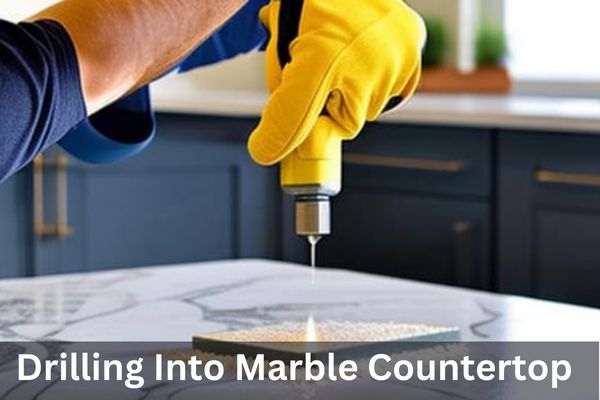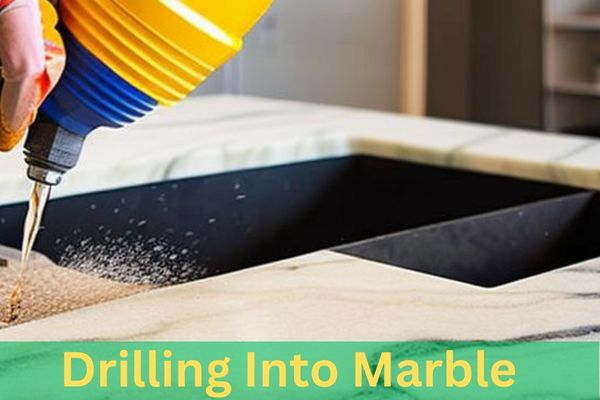Marble countertops are a beautiful addition to any kitchen or bathroom. If you are a DIY enthusiast, drilling into them may seem daunting. Marble is a delicate material that requires special care and attention when drilling. In this guide, we will walk you through the steps to drill into a marble countertop safely and effectively.

Introduction About Drilling Into Marble Countertop
Drilling into marble countertops requires a specific set of tools and techniques to prevent cracking, chipping, or damaging the material. Marble is a natural stone that is porous and prone to scratches, making it a challenging material to work with. However, with the right tools and techniques, you can drill into a marble countertop safely and effectively.

1. Necessary Tools and Materials Needed
Before you begin, make sure you have the following tools and materials:
- Diamond-tipped drill bit
- Drill machine
- Masking tape
- Water bottle or hose
- Rubber suction cup or clamp
- Safety glasses
- Dust mask
- Soft cloth or towel
2. Preparing the Countertop
In order to drill a countertop, the first step is to prepare it. Place a soft cloth or towel underneath the area where you will be drilling to prevent scratching or chipping.
Use masking tape to mark the area where you want to drill the hole. This will prevent the drill from slipping and damaging the surrounding area.
3. Marking the Hole
Once you have marked the area, use a pencil or marker to mark the exact spot where you want to drill the hole. Ensure that the mark is visible and accurate. Use a ruler or measuring tape to ensure the hole is in the correct location.
4. Choose the Right Drill Bit
Selecting the right drill bit is crucial when drilling into marble. Diamond-tipped drill bits are the best option for drilling into marble, as they are durable and long-lasting. They are also designed to withstand the heat generated by drilling into the stone. Make sure the drill bit is the right size for the hole you want to drill.
5. Drilling the Hole Into Marble
Attach the diamond-tipped drill bit to your drill machine. Turn on the drill machine and apply gentle pressure to the drill bit. Keep the drill bit perpendicular to the countertop to prevent it from slipping.
The speed should be gradually increased as you drill at a slow speed. Avoid applying too much pressure, as this can cause the drill bit to overheat and crack the marble.
6. Cooling the Drill Bit
Cooling the drill bit is essential when drilling into marble. Use a water bottle or hose to keep the drill bit and the marble surface cool. Spray water on the drill bit and the area around the hole every few seconds. This will prevent the drill bit from overheating and damaging the marble.
7. Cleaning the Hole
Once you have drilled the hole, use a soft cloth or towel to clean the area around the hole. Make sure there are no debris or dust particles left behind. You can use a vacuum cleaner or a brush to remove any remaining debris.
8. Filling the Hole
If you want to fill the hole, use a marble repair kit. Follow the instructions on the kit to fill the hole and let it dry completely before using the countertop.
FAQ’s
Do you know how to drill through marble without cracking it?
To drill into marble without cracking it, use a diamond-tipped drill bit, keep the drill bit cool with water, and avoid applying too much pressure. Also, mark the area to be drilled with masking tape, start drilling at a slow speed, and clean the hole and the surrounding area carefully after drilling.
What drill bit do you use for marble?
When you are drilling into marble, it’s best to use a diamond-tipped drill bit as it’s more durable and can handle the hardness of the stone. A diamond-coated drill bit is specifically designed to cut through hard materials like marble without cracking or damaging the surface. It’s important to use a slow speed and gentle pressure when drilling to prevent the marble from chipping or breaking.
Can you use a hammer drill on marble?
Yes, you can use a hammer drill on marble, but it’s important to use the right type of drill bit to prevent damaging the surface of the marble. A diamond-tipped drill bit is the best choice for drilling into marble, as it’s more durable and can handle the hardness of the stone. Additionally, it’s important to use a slow speed and gentle pressure when drilling to prevent the marble from cracking or chipping.
What does a stone drill bit look like?
A stone drill bit typically has a pointed, cone-shaped tip with small diamond particles or a diamond coating. The body of the bit is usually cylindrical and made of hardened steel or another durable material.
The shank of the bit, which is inserted into the drill chuck, can vary in shape and size depending on the type of drill. Overall, a stone drill bit is designed to cut through hard materials like marble, granite, and other types of stone.
What happens to marble when it gets wet?
Marble is composed of calcium carbonate which can react with acidic water, resulting in transparent or chalky dull spots. If water is left on the surface for an extended period of time, it can seep into the pores and cause discoloration or damage to the marble. In Addition, water can also cause the marble to erode over time, particularly if it’s exposed to acidic substances or harsh cleaning products.
Conclusion:
By following the steps in this guide, You can successfully drill into a marble countertop. Drilling into a marble countertop requires patience, attention to detail, and the right tools.
It’s also important to keep the drill bit cool with water and wear safety goggles to protect your eyes. While marble can be sensitive to water and acidic substances, with proper care, you can maintain its beauty and functionality. Remember to wipe up any spills or standing water on marble surfaces to prevent staining or damage. With these tips in mind, drilling into a marble countertop can be a successful DIY project.
Thanks for the reading!
